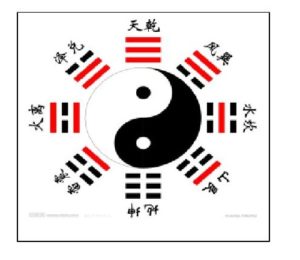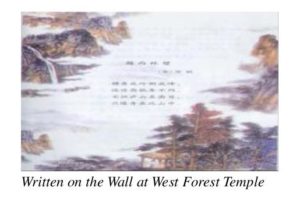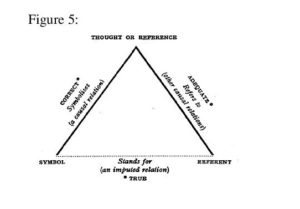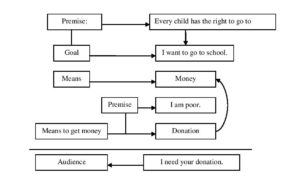ISSA Proceedings 2014 ~ The Possibility Of Visual Argumentation: A Point Of View
No comments yet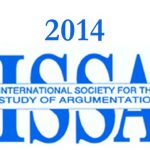 Abstract: The verbal and the visual are different complementary means for argumentation, and there is an uncontentious fact that visual argumentation exists. And, visual argumentation can learn much more from Frege’s theory of meaning, which is helpful for the theorical basis or the philosophical ground of visual argumentation. Finally, some further far-reaching questions are brought forth, especially about the schemes of visual argumentation, and the relation of visual argumentation to artificial intelligence.
Abstract: The verbal and the visual are different complementary means for argumentation, and there is an uncontentious fact that visual argumentation exists. And, visual argumentation can learn much more from Frege’s theory of meaning, which is helpful for the theorical basis or the philosophical ground of visual argumentation. Finally, some further far-reaching questions are brought forth, especially about the schemes of visual argumentation, and the relation of visual argumentation to artificial intelligence.
Keywords: artificial intelligence, philosophical ground, visual argumentation, the context principle, the scheme of visual argumentation
1. Introduction
The visual usually can convey much more meanings that cannot be expressed as well through the verb. Then, can the visual express an argument or an argumentation?
For example, there is a picture (see Figure 1).
When you as an audience see the picture, what would you think? Perhaps there are at least three possibilities:
(1) you don’t know about the related context, so you could not understand what on earth the picture wants to express;
(2) you don’t know about its related context. You don’t care about what it wants to express. You direct your attention at the eyes, the fingers, the color of the picture, and even the pencil, and so on;
(3) you know about the related context, so you could know this is a poster, which is the poster of Hope Project “Big Eyes Girl” in China, and it appeals to the people to donate.
Suppose you could know about the related contexts, and understand what the picture wants to express. Then, as an audience you could have different attitudes to what the poster expresses. For example, three kinds of attitudes are as follows:
Approver A: Yes, I will and prefer to donate to the Hope Project.
Objector B: No, I will not donate to the Hope Project, because I am not very rich, and I myself also need donation.
Objector C: No, I will not donate to the Hope Project, because I don’t believe its organizer. But I prefer to donate to the poor directly.
When the audiences begin their argumentations in their brains, the argumentations seem to take place. Here, some questions will be raised, which are too diversified for a paper, so I will talk some of them roughly:
(1) What are the challenges to the possibility of the concept of visual argumentation (VA for short)? This is about the realistic possibility of visual argumentation.
(2) Why VA is possible in the realm of argumentation? That is to say, how to make sense of the logical possibility of VA?
(3) How can the visuals express an argument or argumentation[i]? And some further questions raised by VA, for example, the schemes of visual argumentation, and the relation of VA to artificial intelligence (AI for short).
I agree with Birdsell and Groarke that the first step toward a theory of visual argument must be a better appreciation of both the possibility of visual meaning and the limits of verbal meaning. (Birdsell & Groarke, 1996) It is obvious that Birdsell & Groarke talk about this issue from pragmatics, not from semantics. I think this is a proper route for talking about this question. The following examples will illustrate three kinds of possibility of visual meaning.
2. What can VA learn from Chinese traditional culture?
2.1 Three relevant examples
The followed three examples are respectively from “The Book of Changes” in the Six Classics, poem and painting, and Buddism. “The Book of Changes” (pronounced Yijing in Chinese) is one of the oldest philosophical books in China. In fact, it is also a book of drawings, and its representative image is in Figure 2.
When you look at this picture at the first sight, what do you think about? Two parts, and eight hexagrams. The clarity is that the hexagrams are not only changing, but also changing regularly. The vagueness is that what on earth the hexagrams express. If you don’t know the explanation about them, and you are difficult to know the meaning of them well and truly, then you cannot tell what they express. So, the clarity is that what the visual itself is. The vagueness is about what on earth the author wants to express.
In this case, we can not tell determinately what the drawing expresses. So, not every visual expresses an argument, just as not every sentence group expresses an argument. Perhaps in the cases like this, the visual can express some proposition, but not argument, because the author’s purpose is not to argument something, but to explain something. Now we turn to the next example, which is the poem and painting. In china, there is a saying, no poem, no painting, and no painting, no poem. That is meaning though poem and painting are two different ways to express human’s feelings/thoughts, they are the sameness at the level of logic. For example, the followed is a poem written by Su Shi, who was a famous poet in Song dynasty. This poem is well-known in China. The poem (see Figure 3) is translated as followed.
[Song dynasty] Su Shi:
From the side, a whole range; from the end, a single peak.
Far, near, high, low, no two parts alike.
Why can’t I tell the true shape of Lu-shan?
Because I myself am in the mountain.
The meaning of this poem is what we saw is affected by the visual angle. Perhaps someone will bring forth an objection-alike here: according to what this poem means, there seems to that, similarly, different audiences cannot have the same thing in their brains for the same visual. My reply is: in this kind of objection there is a difference neglected. What the author faced was a natural object, here is the mountain named Lu-shan. What the audiences face are man-made objects, for example, a drawing or a picture. The makers usually, although not always, try to express clearly what they want to express by the visuals.
If we must make a reason by analogy any way, the elicitation of the example is that the audience will have different visions if they see an object from different point of view; similarly, the audience will have different visions if they see a visual from different point of view, but vision / idea is different from thought[ii]. And, there is a fact that they can see the same thing, for example, it is a mountain or some parts of the same mountain or a visual or some parts of the same visual. The conclusion is: the audiences are affected by the point of view, and the audiences can see the same thing which I will expound in the second part; and, in essence, poem and the drawing is the same one, because they are the different representations of the same one, which is a kind of status. So, to some degree, the verbal and the visual is the same one, because they are the representations of the same one, which is also a kind of status. The visual is different from not only object, but also idea. The Visual is alike the verbal because both of them are the description of the being. The visual and the verbal are different complementary means for argumentation.
The third example talks about, according to Zen Buddhism, the reflection on the relation between the subject and the object. The great master in Zen Buddhism Qingyuan Xingsi in Tang dynasty said:
What you have seen, the mountain is the mountain, and the water is the water.
What you have seen, the mountain isn’t the mountain, and the water isn’t the water.
What you have seen, the mountain is still the mountain, and the water is still the water.
What the above said is there are three levels of outlook in Zen Buddhism: world with me, world without me (anatman), and world beyond me. The elicitation of “three levels of outlook” is that, at bottom, the understanding on the visual is limited and affected heavily by the understanding ability of the audiences. The audience is an important factor that impacts the running of the argumentation. What visuals are is affected by many factors, such as the points of view, and the levels of outlook.
Here, perhaps an objection will be brought forth, that the visual is ambiguous regarding that the audience have different levels of outlook. My answer is: to some degree, this proves well that VA is possible. Argumentation is interpersonal form the surface form, but it is personal from the inner intention.
2.2 Replies to some objections
Along with the birth of VA, there are many objections surrounding it. Here at least two objections will be discussed as an opening.
Objection 1: If what we mean by “argument” is the act of advancing reasonable position in contexts of doubt and difference, then a picture cannot, independent of language, be an argument.
This objection focuses on whether the visual itself can express an argument, and the precedent condition is how to define the concept of argument. Just as there is no consensus on the definition of logic, there is also no consensus on the definition of argument. According to O’Keefe (O’Keefe, 1982), the concept of argument has two definitions. The concept of argument1 is described as involving “a linguistically explicable claim and one or more linguistically explicable reasons”; and the concept of argument2 is described as “overt disagreement… between interactants.” It is obvious that the concept of argument1 is relatively strict, and the concept of argument2 is relatively broadened. About the scope of the concept “argument”, although some scholars, for example, Perelman and Olbrechts-Tyteca (1969) and Blair (1996), think it should be strict; some scholars, for example, Willard (1989) and Hesse (1992), think it should be broadened. They think that the concept “argument” should be clarified from the point of interactive and argumentative communication. Visual arguments are a kind of enthymeme. Here, this opinion hides an important precondition which all discourse is productive of belief. (Hesse, 1992)
Van Eemeren, Grootendorst and Kruiger (1984) also argue that argumentation is necessarily verbal, and argumentation without the use of language is impossible. Toulmin, Rieke and Janik (1979) pointed out that “reasoning could not exist in the absence of language. Both claims and all the considerations used to support them must be expressed by some kind of a linguistic symbol system.” I think there is a fact worthy of noting, when these opinions were given, at that time there is no big data, so those scholars cannot realize the power of visual reasoning in virtue of the big data technology.
A systematic objection as Fleming argued (1996),
Argument is reasoning towards a debatable conclusion. It is a human act conducted in two parts (claim and support) and with awareness of two sides (the claim allows for and even invites opposition). By this definition, something which cannot be broken down into claim and support, and whose claim is not reliably contestable, is not an argument, whatever else it may be and how else it may participate in argument.
I don’t deny the correctness of this opinion, but I must note that here is the concept of “argument”, not the concept of “sentence group.” As Woods and Walton (1982) said, an argument is a set of propositions that can be divided into two categories: premises and conclusion. The word used here in the definition is also proposition, not sentence. As to Fleming argues that a picture can not satisfy the two part structure of argument because “it lacks the internal linear arrangement that characterizes verbal discourse.” (Fleming, 1996) For Fleming[iii], the visual sometimes can serve as support for a linguistic claim, but it itself cannot, without language, be a claim.
For this objection, my question is that, can no any picture really be an argument? Can some pictures, with a certain inner connection and structure, be an argument? The answer from the experience is: VA exists. It is well known that propositions can be expressed in any number of ways, including by signs, signals, and visuals. Fleming didn’t divide different visuals into valid and invalid. But the reality is that, according to the province of argument, visuals can be divided into valid and invalid as well as sentence group. So, we must distinguish the valid visual expressions from other visual expressions. How is a visual expression valid? A visual expression is valid, if and only if it can be judged as true or false. No doubt, for instance, this kind of visual expression exists in the province of legal evidences.
Objection 2: Visual expresses as a form of persuasion and rhetoric, not independently an argument.
According to Blair (1996), there is no doubt that images can be influential in affecting attitudes and beliefs. Still, from the fact that images influence beliefs and attitudes it does not follow that such images are arguments, for there is any number of other ways of influencing attitudes and beliefs besides arguing. The concept of visual argument is an extension of rhetoric’s paradigm into a new domain. If the persuasive function lies at the heart of rhetoric, then any form of persuasion, including visual persuasion, belongs within rhetoric’s province.
I don’t deny that visuals sometimes take its persuasive function, but I don’t think the persuasive function is its one and only function. Just as the functions of the verbal, they include persuasion, argument, imperative, and etiquette. Argument is just one of the functions of the verbal. So, are the functions of the visual just one? No, it is not the truth. In the next place, to some degree, the difference between argument and persuasion is clear. The main difference between argument and persuasion is the purposes of them. The purpose of argument is to prove something is true, and the purpose of persuasion is to persuade the audience regardless of the truth value. According to the intention of certain agent, the visual can be used for both the truth value and persuasion. So, visual expresses not only as a form of persuasion and rhetoric, but also independently an argument. If we expect to find VA in such things as dramatic paintings and sculptures, magazine and other static advertisements, television commercials and political cartoons, (see Bair, 1996) we will be disappointed that there is hardly any qualified one, because most of these visual expresses indeed are not expressions with truth value.
Blair also talked about the importance of VA (1996), and he argues that if suggestiveness is the aim, this is a virtue; where clarity or precision are desiderata, it is a disadvantage. Blair’s main point is that visual arguments are not distinct in essence from verbal arguments. The argument is always a proposition entity, merely expressed differently in the two cases. Therefore VA is not a particular exciting conceptual novelty; they do not constitute a radically different realm of argumentation. According to Bair (1996), the attempt of conceive of the possibility of non-propositional argument comes up empty, and the possibility of non-propositional persuasion is possible. Here, the precondition of Blair’s claim is that the visual can not express propositions distinctly and precisely.
Here, once again, it deserved great notice that the verbal is a kind of means for arguments, then is the verbal is the only and all media instrument though relatively it perhaps the most explicit form? I agree to Birdsell & Groarke (1996), vague and ambiguous are not the distinction between the visual and the verbal, and the visual meaning can be in some cases neither arbitrary nor indetermination; and both the visual and the verbal can convey claims and arguments. Blair mainly cited the concept of argument1 to analyze the concept of visual argument. What it would be like if citing the concept of argument2 to analyze the concept of visual argument?
3. The philosophical ground of VA: sense and reference
If VA is possible, why so many scholars argue it is impossible? At least, probably there is one reason is that a very important difference is confused or neglected: the language and what the language expresses. About this difference, the first system research is Gottlob Frege’s works “Über Sinn und Bedeutung.” (On sense and reference).
The fundamental thoughts of Frege’s theory of meaning are three differences: the first difference is between language and what language expresses, the second one is between concept and object, and the third one is between sense and reference. According to Frege’s context of scientific researches, natural language is often mixed with rhetoric, psychology and others, but what language expresses is the focus. Here our emphasis is the difference between sense and reference (see Figure 4).
What can VA learn from Frege’s theory of meaning? At any rate, VA itself keeps to some fundamental epistemological principles as followed: the context principle, the objectivity principle.
3.1 The context principle
The context principle is the central concept of the theory of VA. According to Frege, the context principle means that “never … ask for the meaning of a word in isolation, but only in the context of a proposition” (Frege [1884/1980] x). In the same way, never ask for the meaning of a picture in isolation, but only in the context of where it occurs. If no knowing about the context of where a picture occurs, you have no knowing about the meaning of that picture.
Though in many instances in our culture the conditions of interpretation of visual expression are indeterminate to a much greater degree than is the case with verbal expression (see Blair, 1996), but many of them are determinate yet. It is undeniable that some of them are very complicated, even the meanings of some visual claims or arguments obviously depend on a complex set of relationships between a particular image/text and a given set of interpreters. “Context” can involve a wide range of cultural assumption, situational cues, time-sensitive information, and/or knowledge of a specific interlocutor. (Birdsell & Groarke, 1996) For instance, some ancient frescoes can be deciphered in line with their contexts and some relevant theories by the experts.
About the contents of the context, Birdsell & Groarke brought forth there are at least three kinds of contexts are important in the evaluation of visual arguments: immediate visual context, immediate verbal context, and visual culture[iv]. For the same visual in different contexts, it will perhaps have different meanings. For example, when Figure 2 is being seen by a person accustomed to Chinese culture, it will be associated with The Book of Changes and the law of changes. When it is being seen by a Korean person or certain persons accustomed to Korean culture, it will be easily associated with the national flag of Korean.
The contexts are the important hidden premises for a valid VA. They supply the basic premises for understanding it rationally, so they must be known by the audiences. The audiences who know about the contexts exclude the reasonable objections on the visual. Otherwise, the visual is obscure for the audiences, and as a result, VA fails to develop rationally. If necessary, providing keywords or sentences for a visual. That will be helpful for clearing up the misunderstandings in VA.
3.2 The objectivity principle
According to Frege, the difference between logic and psychology is distinct, but often confused by many mathematics and logicians. (see Frege [1884/1980]) He set up Begriffsschrift (a formalized language of pure thought modelled upon the language of arithmetic) to avoid the ambiguity of the natural language which involves a lot of psychological contents. Here, the objectivity principle refers to make a difference between language and what language expresses. If we present the triple relationship between language and what language expresses and things, it can be find from Ogden Triangle of Reference (Ogden and Richards, 1923, p.11) (See Figure 5).
In Ogden Triangle of Reference, what symbol is? Symbol is sign, which can be the verbal or the non-verbal. That does not deny that the visual, which is a non-verbal form, can be also the symbol. It can be said that the verbal and non-verbal has the same status and influence in Ogden Triangle of Reference.
There are also both thoughts and ideas in VA. We must pay attention to that difference between them. Our goal here is to distinguish between logical contents and psychological contents in VA. Just as the sentences in the meaning of language, according to Frege, the language there refers to the declarative sentences, not any form of sentences. So, here we must define the scope and domain of VA to the field of the visual involving the truth value. For example, the visual is some kind of evidence, such as in the fields of legal argumentation or natural science. Of course, that straint does not deny other functions of VA, such as persuasion, explanation and rhetoric.
What is the difference between image and visual? Here, visual is objective, referring to everything relating to or using sight, and able to be seen. Image is subjective here, referring to a visual representation (of an object or scene or person or abstraction) produced on a surface in the mind. Some scholars, for example, Fox (1994b, p. 70, 77), think that the image is the “ultimate tool” of nuance, intimation, hint, and suggestion, so that imagemakers focus on values, attitudes, feelings, and effects, caring little about logic, proof, and argument. Perhaps some images make such effect, but many of them make other functions, such as argumentative effect. This opinion also neglected the logical difference between image and visual. Alike verbal sentences, visuals are also the expression of arguments, not the arguments themselves. The visual and what the visual expresses must be distinguished. This is a very important line.
Just as sentences have different types, drawings or pictures also have different types. Here, a drawing or a picture refers to the visual which has an explicit record of facts or objects, and has clear topic understood by the general audiences. I argue that, like an assertive sentence in language, any of such drawings or pictures has its sense and reference. A visual itself has a meaning, which can be a proposition, as a datum. And, what the visual expresses is another meaning, as a claim. Common contexts are the hidden premises. Subsequently, an argument is formed, and the reference of which is relevancy, sufficiency and acceptability. For example, in Figure 1, the argument is as followed: I need donation, because I want to go to school, but I am very poor. Different audience has different responses to its reference, and their responses can be drawn into different pictures. Consequently, a VA is formed.
Postman (1985, pp. 72-73) said, “The photograph itself makes no arguable propositions, makes no extended and unambiguous commentary.” Can the verbal itself make any arguable proposition? No. The verbal and the visual are two kinds of tools for any arguable proposition. Just as hand sign is also a kind of tool for the communication of the human being. Is hand sign the verbal or the visual? I think it is rather the visual.
In addition, Birdsell & Groarke (1996) brought forth the question of representation and resemblance. They are very important in a VA, because they may construct the argumentative aspects. This is also the third prerequisite for a satisfactory account of VA[v]. Note that the discussion of this question implies that the objectivity of VA.
4. Some futher far-reaching questions surrounding the feasibility of VA
To take VA as a strand of argumentation theory, even provisional, will perhaps finally open a new lands for this world. As Birdsell & Groarke said (1996), “A decision to take the visual seriously has important implications for every strand of argumentation theory, for they all emphasize a verbal paradigm which sees arguments as collections of words.” The fact is that, the paradigm is not unique, because arguments can be also as collections of visuals. About any type of informal logic theory, we will ask the possibility of its scheme, and its extensional application. VA is no exception.
4.1 The schemes of VA
Are there any schemes to analyze a visual argument? Yes, the schemes of VA can be constructed, and the scheme will be helpful for analyzing, explaining, assessing, and reconstructing a visual argumentation.
For example, for the poster of Hope Project “Big Eyes Girl,” its scheme of the argument is as followed[vi].
In the above scheme, the major premise is from the context, which is a common sense: every child has right to go to school. The goal is from the visual itself, which can be told in the verbal or from what the picture expressed directly: I want to go to school. The means are also from the context: I need money to go to school because I have to buy pencils, exercises books, and so on. The minor premise also from what the picture expressed directly: I am poor and have no enough money to go to school. Finally, the conclusion is the result of the argument: I need your donation.
In addition, as to Figure 1, those three kinds of attitudes enumerated can be expressed by the pictures, and that is not only possible, but also feasible. For example, there are gesture language, silent movies, and children’s picture story books without any verbal.
Up to now, we can construct a structure for VA, which should include three factors: the context, the interpersonal argument, and the reasonability. This structure for VA can be expressed as <C, I, R>. Any VA is a reasonability of an interpersonal argument in some certain context.
4.2 The relation of VA to AI
We are conditioned to reasoning and inference by virtue of the verbal, and don’t realize the possibility of the visual. In essence, VA is a new epistemology, which can make reasoning by the visual, not by the verbal and the voice. Now that VA is possible, can we inference in virtue of the consistency, and the coherence of the visual?
Perhaps one day just like what we saw in the American TV serial named “Person of Interest,” we can apply masterly the scheme of visual argumentation into AI, and consequently make the qualitative progress in the field of AI.
In the TV serial “Person of Interest,” A computer genius built the machine, which can identify automatically who is criminal suspect and who is not. The machine can reason validly only by the visual reasoning. Of course, there should consist of the process of analyzing, contrasting and assessing the visuals in the machine. Everyone is being watched by the cameras all around, and everyone has the unique social security number. A social security number will be given by the machine if the corresponding person has the performance disobey the attributes, such as the consistency and the coherence, of visual reasoning. For instance, in certain set of the TV serial, a female doctor works as a doctor in a hospital and drinks all the nights in a bar for several days on end. This is abnormal for anyone because a person needs fixed sleep unless some wrong with him/her. So the number of this female doctor is given by the machine, and the story of the play proofs the correctness of the machine.
An objection may be brought forth, that the machine is man-made, which means its procedure coding is also man-made that cannot be totally the visual. But this does not deny that the reasoning is a different type from the verbal one. The important issue here perhaps is not whether VA can be running completely independent of the verbal, just as the argumentations with the verbal sometimes cannot be run well without any supports, but its running makes sense to the development of AI. Although this TV serial is fictional, the visual reasoning is rooted in reality, and for example, we can find their traces in some legal reasoning and argumentations. Meanwhile, the question of dynamic visual is being solved by the rapid development of the dynamic cognitive science. So, VA could have important relations to AI.
Of course, the ethics of visual argumentation will be on the agenda. Should we hand over our analyzing abilities and decision-making power to the computer? This is another matter, and the precondition is that VA has soundness, adequacy and completeness.
Acknowledgements
The original version of this paper was presented at the Centre for Research in Reasoning, Argumentation and Rhetoric, Windsor University, on October 3 2013. I wish to thank Christopher W. Tindale, Han V. Hansen, Douglas Walton, J. Anthony Blair and Leo A. Groarke for important corrections, constructive criticisms, suggestions and lots of kind help.
NOTES
i. In this paper, I don’t deliberately distinguish the difference between visual argument and visual argumentation, because in general the visual can express an argumentation if it can express an argument.
ii. See the second part, which clarifies the difference between idea and thought.
iii. Fleming provided a long bibliography for the rejection of the possibility of VA
iv. Birdsell & Groarke has given an explicit explanation for these concepts. I don’t think they are sufficient contents for the context of a visual argument, for example, sometimes the indirect cues deserve much more attention, but I agree those three aspects are the fundamental contents.
v. According to Birdsell & Groarke, the other two prerequisites for a satisfactory account of VA are: we must accept the possibility of visual meaning, and we must make more of an effort to consider images in context.
vi. I wish to thank Douglas Walton for the original version of this scheme. Responsibility for the scheme and the views expressed here are, of course, mine alone
References
Blair, J. Anthony. (1996). The Possibility and Actuality of Visual Arguments. Argumentation and Advocacy, Vol. 33, Issue 1, 23-39.
Birdsell, David S. & Groarke, Leo. (1996). The Possibility and Actuality of Visual Arguments. Argumentation and Advocacy, Vol. 33, Issue 1, 1-10.
Chryslee, Gail J., Foss, Sonja K., & Ranney, Arthur L. (1996). The Construction of Claims in Visual Argumentation. VCQ, Spring 1996.
Fleming, David. (1996). Can Pictures be Arguments? Argumentation and Advocacy, Vol. 33, Issue 1, 11-22.
Frege, Gottlob (1884/1980). The Foundations of Arithmetic. Trans. J. L. Austin. Second Revised Edition. Evanston, Illinois: Northwestern University Press.
Fox, R. F. (1994b). Where we live. In R. F. Fox (Ed.), Images in language, media, and mind (pp. 69-91). Urbana, IL: NCTE.
Hesse, D. D. (1992). Aristotle’s Poetics and Rhetoric: Narrative as Rhetoric’s Fourth Mode. In R. Andrews (Ed.), Rebirth of Rhetoric: Essays in Language, Culture and Education (pp. 19-38). London: Routledge.
Ogden, C. K., & Richards, I. A. (1923). The Meaning of Meaning: A Study of the Influence of Language upon Thought and of the Science of Symbolism. New York: Harcourt , Brace & World, Inc.
O’Keefe, D. J. (1982). The Concepts of Argument and Arguing. In J. R. Cox and C. A. Willard (Eds.), Advances in argumentation theory and research (pp. 3-23). Carbondale, IL: Southern Illinois University Press.
Postman, N. (1985). Amusing ourselves to death: Public discourse in the age of show business. New York: Penguin.
Toulmin, S., Rieke, R., & Janik, A. (1979). An Introduction to Reasoning. New York: Macmillan.
Willard, C. A. (1989). A Theory of Argumentation. Tuscaloosa, AL: University of Alabama Press.
You May Also Like
Comments
Leave a Reply

